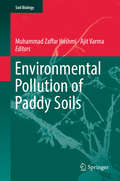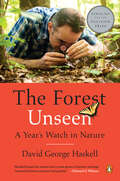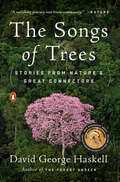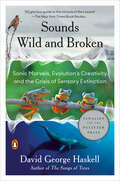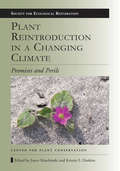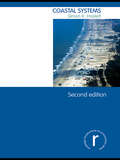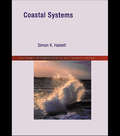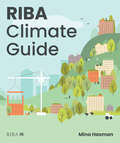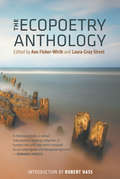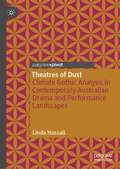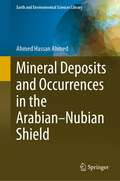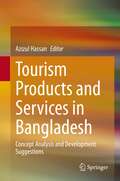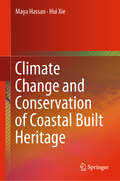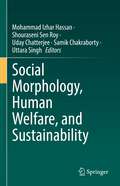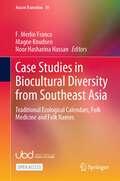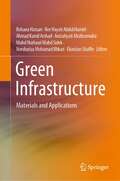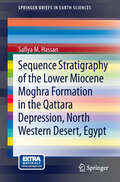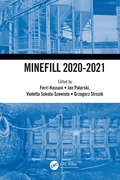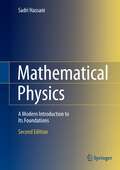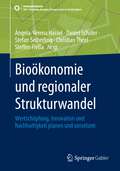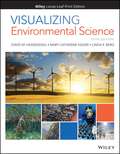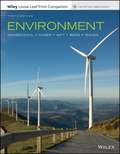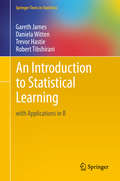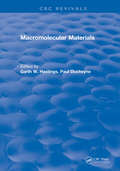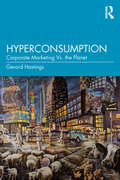- Table View
- List View
Environmental Pollution of Paddy Soils (Soil Biology #53)
by Muhammad Zaffar Hashmi Ajit VarmaThe paddy field is a unique agro-ecosystem and provides services such as food, nutrient recycling and diverse habitats. However, chemical contamination of paddy soils has degraded the quality of this important ecosystem. This book provides an overview of our current understanding of paddy soil pollution, addressing topics such as the major types of pollutants in contaminated paddy soil ecosystems; factors affecting the fate of pollutants in paddy soil; biomonitoring approaches to assess the contaminated paddy soil; the impact of chemicals on soil microbial diversity; and climate change. It also covers arsenic and heavy metal pollution of paddy soils and their impact on rice quality. Further, new emerging contaminants such as antibiotics and antibiotics resistance genes (ARGs) in paddy soil and their impact on environmental health are also discussed. The last chapters focus on the bioremediation approaches for the management of paddy soils.
The Forest Unseen
by David George HaskellA 2013 Pulitzer Prize Finalist for General Nonfiction Winner of the 2013 Best Book Award from the National Academies A Finalist for the PEN/E.O. Wilson Literary Science Writing Award Winner of the National Outdoor Book Award Winner of the Reed Award from the Southern Environmental Law Center A biologist reveals the secret world hidden in a single square meter of forest Written with remarkable grace and empathy, The Forest Unseen is a grand tour of nature in all its profundity. Biologist David George Haskell uses a one-square-meter patch of old-growth Tennessee forest as a window onto the entire natural world. Visiting it almost daily for one year to trace nature's path through the seasons, he brings the forest and its inhabitants to vivid life. Beginning with simple observations--a salamander scuttling across the leaf litter, the first blossom of spring wildflowers--Haskell spins a brilliant web of biology, ecology, and poetry, explaining the science binding together ecosystems that have cycled for thousands--sometimes millions--of years.
The Songs of Trees: Stories from Nature's Great Connectors
by David George HaskellThe author of the Pulitzer Prize finalist The Forest Unseen visits with nature’s most magnificent networkers — trees “Here is a book to nourish the spirit. The Songs of Trees is a powerful argument against the ways in which humankind has severed the very biological networks that give us our place in the world. Listen as David Haskell takes his stethoscope to the heart of nature - and discover the poetry and music contained within.” -- Peter Wohlleben, author of The Hidden Life of TreesDavid Haskell’s award-winning The Forest Unseen won acclaim for eloquent writing and deep engagement with the natural world. Now, Haskell brings his powers of observation to the biological networks that surround all species, including humans. Haskell repeatedly visits a dozen trees around the world, exploring the trees’ connections with webs of fungi, bacterial communities, cooperative and destructive animals, and other plants. An Amazonian ceibo tree reveals the rich ecological turmoil of the tropical forest, along with threats from expanding oil fields. Thousands of miles away, the roots of a balsam fir in Canada survive in poor soil only with the help of fungal partners. These links are nearly two billion years old: the fir’s roots cling to rocks containing fossils of the first networked cells. By unearthing charcoal left by Ice Age humans and petrified redwoods in the Rocky Mountains, Haskell shows how the Earth’s climate has emerged from exchanges among trees, soil communities, and the atmosphere. Now humans have transformed these networks, powering our societies with wood, tending some forests, but destroying others. Haskell also attends to trees in places where humans seem to have subdued “nature” – a pear tree on a Manhattan sidewalk, an olive tree in Jerusalem, a Japanese bonsai– demonstrating that wildness permeates every location. Every living being is not only sustained by biological connections, but is made from these relationships. Haskell shows that this networked view of life enriches our understanding of biology, human nature, and ethics. When we listen to trees, nature’s great connectors, we learn how to inhabit the relationships that give life its source, substance, and beauty.
Sounds Wild and Broken: Sonic Marvels, Evolution's Creativity, and the Crisis of Sensory Extinction
by David George Haskell&“A symphony, filled with the music of life.&” —Elizabeth Kolbert, author of The Sixth ExtinctionA lyrical exploration of the diverse sounds of our planet, the creative processes that produced these marvels, and the perils that sonic diversity now facesWe live on a planet alive with song, music, and speech. David Haskell explores how these wonders came to be. In rain forests shimmering with insect sound and swamps pulsing with frog calls we learn about evolution&’s creative powers. From birds in the Rocky Mountains and on the streets of Paris, we discover how animals learn their songs and adapt to new environments. Below the waves, we hear our kinship to beings as different as snapping shrimp, toadfish, and whales. In the startlingly divergent sonic vibes of the animals of different continents, we experience the legacies of plate tectonics, the deep history of animal groups and their movements around the world, and the quirks of aesthetic evolution. Starting with the origins of animal song and traversing the whole arc of Earth history, Haskell illuminates and celebrates the emergence of the varied sounds of our world. In mammoth ivory flutes from Paleolithic caves, violins in modern concert halls, and electronic music in earbuds, we learn that human music and language belong within this story of ecology and evolution. Yet we are also destroyers, now silencing or smothering many of the sounds of the living Earth. Haskell takes us to threatened forests, noise-filled oceans, and loud city streets, and shows that sonic crises are not mere losses of sensory ornament. Sound is a generative force, and so the erasure of sonic diversity makes the world less creative, just, and beautiful. The appreciation of the beauty and brokenness of sound is therefore an important guide in today&’s convulsions and crises of change and inequity. Sounds Wild and Broken is an invitation to listen, wonder, belong, and act.
Plant Reintroduction in a Changing Climate: Promises and Perils (Science Practice Ecological Restoration)
by Kristin E. Haskins Joyce MaschinskiThis volume presents a comprehensive review of reintroduction projects and practices, the circumstances of their successes or failures, lessons learned, and the potential role for reintroductions in preserving species threatened by climate change. Contributors examine current plant reintroduction practices, from selecting appropriate source material and recipient sites to assessing population demography. The findings culminate in a set of Best Reintroduction Practice Guidelines, included in an appendix to the book. These guidelines cover stages from planning and implementation to long-term monitoring, and offer not only recommended actions but also checklists of questions to consider that are applicable to projects around the world. Plant Reintroduction in a Changing Climate is a comprehensive and accessible reference for practitioners to use in planning and executing rare plant reintroductions.
Coastal Systems
by Simon HaslettThe coast represents the crossroads between the oceans, land and atmosphere, and all three contribute to the physical and ecological evolution of coastlines. Coasts are dynamic systems, with identifiable inputs and outputs of energy and material. Changes to input force coasts to respond, often in dramatic ways as attested by the impacts of the Indian Ocean tsunami in 2004, the landfall of Hurricane Katrina along the Gulf Coast of the USA in 2005, and the steady rise of global warming driven sea-level. More than half the world’s human population lives at the coast, and here people often come into conflict with natural coastal processes. Research continues to unravel the relationship between coastal processes and society, so that we may better appreciate, understand, manage and live safely within this unique global environment. Coastal Systems offers a concise introduction to the processes, landforms, ecosystems and management of this important global environment. New to the second edition is a greater emphasis on the role of high-energy events, such as storms and tsunamis, which have manifested themselves with catastrophic effects in recent years. There is also a new concluding chapter, and updated guides to the ever-growing coastal literature. Each chapter is illustrated and furnished with topical case studies from around the world. Introductory chapters establish the importance of coasts, and explain how they are studied within a systems framework. Subsequent chapters explore the role of waves, tides, rivers and sea-level change in coastal evolution. Students will benefit from summary points, themed boxes, engaging discussion questions and new graded annotated guides to further reading at the end of each chapter. Additionally, a comprehensive glossary of technical terms and an extensive bibliography are provided. The book is highly illustrated with diagrams and original plates. The comprehensive balance of illustrations and academic thought provides a well balanced view between the role of coastal catastrophes and gradual processes, also examining the impact humans and society have and continue to have on the coastal environment.
Coastal Systems (Routledge Introductions to Environment: Environmental Science)
by Simon HaslettCoastal Systems offers a concise introduction to the processes, landforms, ecosystems, and management of coasts. Each chapter is illustrated and includes topical case studies from around the world such as:* Tsunami's in Papua New Guinea* cliff collapse in Southern England* the Great Barrier Reef* the Indian 'Super Cyclone' of 1999* the impact of development in the Florida Keys.Introductory chapters establish the importance of coasts and explain how they are studied within a system framework. Subsequent chapters explore the role of waves, rivers and sea level changes in coastal evolution. The final chapter reviews the human pressures and management of coastal systems.
RIBA Climate Guide
by Mina HasmanClimate change is a threat to humankind, which requires immediate action. The built environment has a vital role to play in responding to the climate emergency. There is a pressing need for architects to acquire the requisite skills and knowledge to design buildings that deliver sustainable outcomes, meeting the RIBA 2030 Climate Challenge and mandatory competence in climate literacy. Equipping you with the key information that built environment professionals require to halt climate change and mitigate its impacts in your day-to-day work, this book is organised around six overarching topics: 1. Human Factors 2.Circular Economy 3.Energy and Carbon 4.Water 5.Ecology and Biodiversity 6.Connectivity and Transport Featuring images and original illustrations, each themed section will guide you through fundamental elements and competencies for creating a sustainable design and delivery framework that can be implemented by you in your practice. Contextualising the climate emergency within the built environment landscape, the guide maps out the essential background knowledge around climate science, international agreements, legislations, commitments and roadmaps. A collection of short, building- and urban-scale case studies present key takeaways, illustrating real-life applications of design strategies and industry-wide tools, as well as standards that are deployed in climate-conscious built environments all around the world.
The Ecopoetry Anthology
by Robert Hass Laura-Gray Street Ann Fisher-WirthDefinitive and daring, The Ecopoetry Anthology is the authoritative collection of contemporary American poetry about nature and the environment--in all its glory and challenge. From praise to lament, the work covers the range of human response to an increasingly complex and often disturbing natural world and inquires of our human place in a vastness beyond the human.To establish the antecedents of today's writing,The Ecopoetry Anthology presents a historical section that includes poetry written from roughly the mid-nineteenth to the mid-twentieth century. Iconic American poets like Walt Whitman and Emily Dickinson are followed by more modern poets like Wallace Stevens, William Carlos Williams, Ezra Pound, and even more recent foundational work by poets like Theodore Roethke, Elizabeth Bishop, Robert Hayden, and Muriel Rukeyser. With subtle discernment, the editors portray our country's rich heritage and dramatic range of writing about the natural world around us.
Theatres of Dust: Climate Gothic Analysis in Contemporary Australian Drama and Performance Landscapes
by Linda HassallThrough a contemporary Gothic lens, the book explores theatre theories, processes and practices that explore; the impacts of continuing drought and natural disaster, the conflicts concerning resource extraction and mining and current political debates focussed on climate change denial. While these issues can be argued from various political and economic platforms, theatrical investigations as discussed here suggest that scholars and theatre makers are becoming empowered to dramaturgically explore the ecological challenges we face now and may face in the future. In doing so the book proposes that theatre can engage in not only climate change analysis and discussion but can develop climate literacies in a broader socio-cultural context.
Mineral Deposits and Occurrences in the Arabian–Nubian Shield (Earth and Environmental Sciences Library)
by Ahmed Hassan AhmedThis book presents a detailed review of the mineral deposits and occurrences in the Arabian-Nubian Shield (ANS), including their distribution, mineralization styles, economic importance, and geological controls on the mineralization. The purpose of the book is to compile the results of past and recent investigations on mineral deposits and occurrences in the ANS that covering the countries of (Saudi Arabia, Yemen, Egypt, Sudan, Eritrea, and Ethiopia). In this regard, it discusses in detail the various genetic mineralization styles in the ANS including: (1) magmatic mineral deposits associated with mafic-ultramafic rocks (e.g. chromite, Ni-Cu-Co-PGE magmatic sulfides, Fe-Ti-V oxides), (2) intrusion-related (magmatic-hydrothermal) deposits associated with felsic to intermediate rocks (porphyry, epithermal Au-Ag/sulfide vein type family, skarn, granite-related pegmatite-REE deposits), (3) hydrothermal orogenic gold and volcanogenic massive sulfide (VMS) deposits, as well as (4) surficial mineral deposits (chemical-sedimentary, residual, mechanical and supergene enrichment deposits).
Tourism Products and Services in Bangladesh: Concept Analysis and Development Suggestions
by Azizul HassanThis book provides the latest research in the application of innovative technology to the tourism industry in Bangladesh, covering the perspectives, theories, issues, complexities, as well as opportunities and the challenges present. This book provides a blend of comprehensive and cross disciplinary as well as international insights from contributors to cover the various technologies in tourism. This book focuses on the importance of technologies in tourism, specifically the application and practice of such technologies including the relevant niches in tourism. This book also comprehensively highlights technologies that are impacting the tourism industry in Asia as well as reveals the specific constraints. The contents of this book deal with distinct topics such as mobile computing, new product designs, innovative technology usages in tourism promotion, technology-driven sustainable tourism development, location-based apps, mobility, accessibility and so on. This book is a significant contribution towards the very limited knowledge and under published area of tourism in Bangladesh. This book is designed to accommodate readers that from both both qualitative and quantitative research theory and practices. This book identifies specific examples of the existing tourism products and services in order to better promote and boost the tourism industry by suggesting tourism products and services available in Bangladesh. This book addresses a number of key issues and solutions by examining the products and services and the need for improved tourism marketing and development in Bangladesh as the central themes.
Climate Change and Conservation of Coastal Built Heritage
by Maya Hassan Hui XieThis book presents the preservation principles and the current environmental challenges relating to monitoring heritage sites and buildings under the effects of climate change. It provides a clear overview of conservation action levels and the importance of participation and cooperation between them, and discusses evaluation and management methods, thermal comfort for the common usages, and conceptual methods for enhancing the built heritage. The research presented employed the “Zoom In, Zoom Out” approach for monitoring the Syrian coastal heritage sites threatened by the direct and indirect effects of climate change. Lastly, the book establishes the basic principles and conservation strategies for preserving the coastal heritage sites and buildings. As such, it is a valuable reference resource for researchers, developers, architects, and conservators involved in protecting the architectural heritage in coastal areas. It can also be used as a guidebook on preserving and monitoring built heritage sites at both macro and micro levels.
Social Morphology, Human Welfare, and Sustainability
by Mohammad Izhar Hassan Shouraseni Sen Roy Uday Chatterjee Samik Chakraborty Uttara SinghThis volume discusses a broad range of human welfare problems associated with and stemming from social issues, natural resource deficiencies, environmental hazards, vulnerability to climate change, and sustainability challenges. The chapters form a framework centered around the concept of social morphology, i.e. the role of humans in shaping society, and associated human-nature interactions which inform the ability to achieve sustainable welfare and well-being. The book is divided in six sections. Section I contains the introductory chapters where the book explores shifting interfaces between environment, society, and sustainability outcomes. Section II discusses contemporary issues of social welfare, and covers sustainable approaches in geo-heritage and ecotourism. Section III addresses the roots of various social conflicts and inequalities in relation to overpopulation, poverty, illiteracy, employment concerns, and human migration. Section IV highlights social security and areas of social deprivation, including urban affordability, gender equality, and women’s health. Section V covers social issues resulting from natural hazards and disasters. Section VI concludes the book with a discussion of the way forward for social sustainability. The book will be of interest to students, researchers, policy makers, environmentalists, NGOs, and social scientists.
Case Studies in Biocultural Diversity from Southeast Asia: Traditional Ecological Calendars, Folk Medicine and Folk Names (Asia in Transition #19)
by Noor Hasharina Hassan F. Merlin Franco Magne KnudsenThis open access book demonstrates the linkages between local languages, traditional knowledge, and biodiversity at the landscape level in Asia, providing a fresh approach to discussions on Asia’s biocultural diversity. The book carries forward earlier analyses but importantly focuses on ‘traditional ecological calendars,’ ‘folk medicine,’ and ‘folk names’ in the context of the vital importance of maintaining biological, cultural, and linguistic diversity. It does this by addressing a range of cases and issues in relation to Southeast Asia: Brunei Darussalam, Indonesia, Malaysia, the Philippines, and North-East India. The several chapters demonstrate the ways in which the various forms of knowledge of the environment and its categorizations are important in areas such as landscape and resource management and conservation. They also demonstrate that environmental knowledge and the practical skills which accompany it are not necessarily widely shared. This book sends important messages to those who care about the sustainability of our environment, the maintenance of its biocultural diversity, or at least the maintenance of what remains of it because much has changed. This interdisciplinary collection draws from a wide range of disciplines and is of appeal to students and scholars in anthropology, environmental studies, geography, biodiversity, and linguistics.
Green Infrastructure: Materials and Applications
by Rohana Hassan Nor Hayati Abdul Hamid Ahmad Kamil Arshad Anizahyati Alisibramulisi Muhd Norhasri Muhd Sidek Norshariza Mohamad Bhkari Ekarizan ShaffieThis book presents the meaning of green infrastructure and its concerns to the contribution of materials and applications. It explores the evolving contested material under “green infrastructure” covering timber, concrete, soil, and pavement. It discusses the resistance to the ambiguity of managing the construction of green infrastructure and drawing on wider debates around applications and processes on construction. These contributions are by no means definitive, but rather an attempt to provide a detached and holistic perspective on the engineering “green infrastructure” concept.
Sequence Stratigraphy of the Lower Miocene Moghra Formation in the Qattara Depression, North Western Desert, Egypt
by Safiya M. HassanThe Qattara Depression is part of the Northwestern Desert in Egypt and is home to the second lowest point in Africa at -133 meters below sea level. Therefore, before any projects can be carried out in this area, we must first understand the geology of the land. The present study deals with the high-resolution sequence stratigraphic analysis of the Lower Miocene Moghra Formation outcrops in the Qattara Depression Region. The literature on the sedimentology and sequence stratigraphy of the Moghra Formation has been sparse to date, despite some excellent work over the years by academic and petroleum workers. Moreover, the area studied is within what was once a front-line of World War II, where mine fields and war relics are scattered and cover wide reaches. This has resulted in limited geologic mapping in the past. Thus, great attention is paid in this study to establishing a robust sedimentology and high-resolution sequence stratigraphic framework for the Lower Miocene Moghra Formation. Included are works based on outcrops and, most importantly, new sedimentological and chronostratigraphic information not previously available.
Minefill 2020-2021: Proceedings of the 13th International Symposium on Mining with Backfill, 25-28 May 2021, Katowice, Poland
by Ferri HassaniThe series of International Symposiums on Mining with Backfill explores both the theoretical and practical aspects of the application of mine fill, with many case studies from both underground and open-pit mines. Minefill attendees and the Proceedings book audience include mining practitioners, engineering students, operating and regulatory professionals, consultants, academics, researchers, and interested individuals and groups.The papers presented at Minefill symposiums regularly offer the novelties and most modern technical solutions in technology, equipment, and research. In that way, the papers submitted for the Minefill Symposia represent the highest quality and level in the conference domain. For the 2020-2021 edition organizers hope that the papers presented in this publication will also be received with interest by readers around the world, providing inspiration and valuable examples for industry and R&D research.
Mathematical Physics: A Modern Introduction to Its Foundations
by Sadri HassaniThe goal of this book is to expose the reader to the indispensable role that mathematics---often very abstract---plays in modern physics. Starting with the notion of vector spaces, the first half of the book develops topics as diverse as algebras, classical orthogonal polynomials, Fourier analysis, complex analysis, differential and integral equations, operator theory, and multi-dimensional Green's functions. The second half of the book introduces groups, manifolds, Lie groups and their representations, Clifford algebras and their representations, and fiber bundles and their applications to differential geometry and gauge theories. This second edition is a substantial revision of the first one with a complete rewriting of many chapters and the addition of new ones, including chapters on algebras, representation of Clifford algebras and spinors, fiber bundles, and gauge theories. The spirit of the first edition, namely the balance between rigor and physical application, has been maintained, as is the abundance of historical notes and worked out examples that demonstrate the "unreasonable effectiveness of mathematics" in modern physics. Einstein has famously said, "The most incomprehensible thing about nature is that it is comprehensible." What he had in mind was reiterated in another one of his famous quotes concerning the question of how " ... mathematics, being after all a product of human thought, is so admirably appropriate to the objects of reality." It is a question that comes to everyone's mind when encountering the highly abstract mathematics required for a deep understanding of modern physics. It is the experience that Eugene Wigner so profoundly described as "the unreasonable effectiveness of mathematics in the natural sciences." Some praise for the previous edition: PAGEOPH [Pure and Applied Geophysics] Review by Daniel Wojcik, University of Maryland "This volume should be a welcome addition to any collection. The book is well written and explanations are usually clear. Lives of famous mathematicians and physicists are scattered within the book. They are quite extended, often amusing, making nice interludes. Numerous exercises help the student practice the methods introduced. ... I have recently been using this book for an extended time and acquired a liking for it. Among all the available books treating mathematical methods of physics this one certainly stands out and assuredly it would suit the needs of many physics readers." ZENTRALBLATT MATH Review by G.Roepstorff, University of Aachen, Germany "... Unlike most existing texts with the same emphasis and audience, which are merely collections of facts and formulas, the present book is more systematic, self-contained, with a level of presentation that tends to be more formal and abstract. This entails proving a large number of theorems, lemmas, and corollaries, deferring most of the applications that physics students might be interested in to the example sections in small print. Indeed, there are 350 worked-out examples and about 850 problems. ... A very nice feature is the way the author intertwines the formalism with the life stories and anecdotes of some mathematicians and physicists, leading at their times. As is often the case, the historical view point helps to understand and appreciate the ideas presented in the text. ... For the physics student in the middle of his training, it will certainly prove to be extremely useful." THE PHYSICIST Review by Paul Davies, Orion Productions, Adelaide, Australia "I am pleased to have so many topics collected in a single volume. All the tricks are there of course, but supported by sufficient rigour and substantiation to make the dedicated mathematical physicist sigh with delight." EMS [EUROPEAN MATHEMATICAL SOCIETY] NEWSLETTER "This book is a condensed exposition of the mathematics that is met in most parts of physics. The presentation attains a very good balance between the formal introduction of concepts, theorems and proofs on one hand, and the applied approach on the other, with many examples, fully...
Bioökonomie und regionaler Strukturwandel: Wertschöpfung, Innovation und Nachhaltigkeit planen und umsetzen (SDG - Forschung, Konzepte, Lösungsansätze zur Nachhaltigkeit)
by Angela-Verena Hassel Daniel Schiller Stefan Seiberling Christian Theel Steffen FleßaBioökonomie ist eine neue branchenübergreifende Form des Wirtschaftens, die das Potenzial hat, die bisherige Ökonomie und einzelne Regionen grundlegend zu verändern. Dieser Überzeugung folgend stellen die Herausgeber und Autoren dieses Buches den aktuellen Wissenstand aus Theorie und Praxis der Bioökonomie zusammen, entwickeln neue Methoden für einen bioökonomischen Strukturwandel und reflektieren bestehende Bioökonomiekonzepte. Der komplexe und vielschichtige Prozess einer pflanzenbasierten Bioökonomie in ländlichen Räumen wird aus unterschiedlichen Perspektiven betrachtet. Zunächst werden ökonomische Grundlagen sowohl aus gesamt- als auch aus einzelwirtschaftlicher Sicht diskutiert. Dem schließen sich Beispiele an, wie regionale Innovationsnetzwerke und Wertschöpfungsketten der Bioökonomie einen Beitrag zur nachhaltigen Regionalentwicklung und zum gesellschaftlichen Wandel leisten können. Die darauf aufbauende Analyse legt dar, wie verschiedene Akteure und Prozesse eine regionale Bioökonomie in der Praxis etablieren können. Ausgewählte Anwendungs- und Umsetzungsbeispiele für Innovationen pflanzenbasierter Bioökonomie im nordöstlichen Mecklenburg-Vorpommern runden das Buch ab und zeigen das Potenzial für eine Transformation der Wirtschaft in der Region und darüber hinaus.
Visualizing Environmental Science
by David M. Hassenzahl Mary Catherine Hager Linda R. BergThe 5th Edition of Visualizing Environmental Science provides students with a valuable opportunity to identify and connect the central issues of environmental science through a visual approach. Beautifully illustrated, this fifth edition shows students what the discipline is all about--its main concepts and applications--while also instilling an appreciation and excitement about the richness of the subject. This edition is thoroughly refined and expanded; the visuals utilize insights from research on student learning and feedback from users.
Environment
by David M. Hassenzahl Mary Catherine Hager Nancy Y. Gift Linda R. Berg Peter H. RavenEnvironment, Tenth Edition helps students understand the connection between the core concepts of the Environmental Science and their daily lives. The 10th edition enhanced e-text features a rich, interactive collection of current case studies and in-text examples, which provides students with the tools to understand, apply, and think critically about environmental science. It also provides instructors with powerful tools to assess individual students progresses well as the class as a whole.
An Introduction to Statistical Learning: with Applications in R (Springer Texts in Statistics #103)
by Trevor Hastie Gareth James Robert Tibshirani Daniela WittenAn Introduction to Statistical Learning provides an accessible overview of the field of statistical learning, an essential toolset for making sense of the vast and complex data sets that have emerged in fields ranging from biology to finance to marketing to astrophysics in the past twenty years. This book presents some of the most important modeling and prediction techniques, along with relevant applications. Topics include linear regression, classification, resampling methods, shrinkage approaches, tree-based methods, support vector machines, clustering, and more. Color graphics and real-world examples are used to illustrate the methods presented. Since the goal of this textbook is to facilitate the use of these statistical learning techniques by practitioners in science, industry, and other fields, each chapter contains a tutorial on implementing the analyses and methods presented in R, an extremely popular open source statistical software platform. Two of the authors co-wrote The Elements of Statistical Learning (Hastie, Tibshirani and Friedman, 2nd edition 2009), a popular reference book for statistics and machine learning researchers. An Introduction to Statistical Learning covers many of the same topics, but at a level accessible to a much broader audience. This book is targeted at statisticians and non-statisticians alike who wish to use cutting-edge statistical learning techniques to analyze their data. The text assumes only a previous course in linear regression and no knowledge of matrix algebra.
Macromolecular Materials
by HastingsThis volume deals with some basic considerations of structure and its relation to function. After outlining some basic principles in the first chapter, including manufacturing effects, structural determination is discussed in detail. This is important since adequate characterization in terms of molecular size is necessary for a proper understanding and suse. The theme of interrelationships between structure and properties is developed in the next chapters. The second part of the volume deals with selected applications in which the development and sue of macromolecultar materials in specific applications is described.The selection of applications includes synthetic and natural polymers and the range of medical areas involved include orthopedics, dialysis, drug release (macromolecular pharmacology) blood contact, and plastic surgery. Since the list could not be completely comprehensive, these represent areas of special development or of continuing problems.
Hyperconsumption: Corporate Marketing vs. the Planet
by Gerard HastingsDiving deep into the world of corporate marketing, this incisive and eye-opening work shows how, in the hands of the corporation, business has become manipulative, divisive and disastrously at odds with the needs of the natural world. It calls on us to rethink and rebel. The corporate marketing blitz is driven by a simple economic truth: profits depend on demand always exceeding supply. A multi-billion-dollar global industry has therefore been created with the sole aim of turning us into devout consumers. Gerard Hastings invites us to explore alternatives to a system that is threatening our survival. He explores what it is to be human, how marketing can be used to do good rather than harm and the potential of alternative models that empower us to be citizens, not just consumers. Professionals and students in the business, marketing, public health, environmental and political sectors – as well as concerned citizens who know that business as usual is not an option – will value this accessible guide to what is going wrong with our current business models and how these failings can be addressed.
